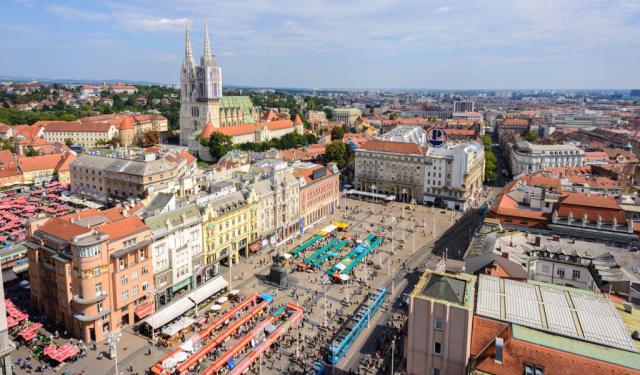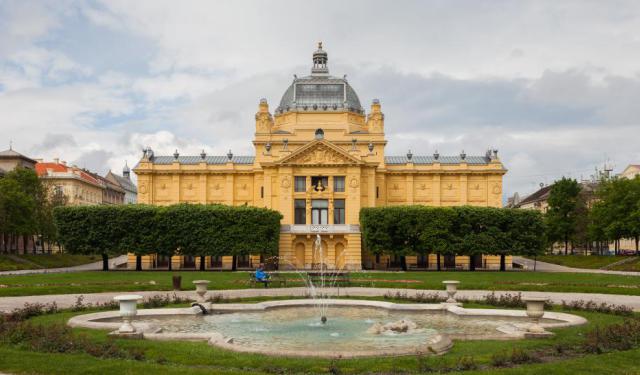
Ban Jelačić Square, Zagreb (must see)
Ban Jelacic Square is named for Josip Jelacic, Ban (ruler) of Croatia and leader of Croatian independence from Austria in the 19th century. The name, locally, is Jelacic Plac. It is in the center of Zagreb's downtown pedestrian zone. It is located below the early medieval settlements of Gradec (1242) and Kaptol (1094), south of Dolac Market.
In 1641 it became necessary to create a new marketplace outside the old nucleus of Gradec and Kaptol, near the spring of Mandusevec. Initially called Mandusevec, the square's name was later changed to Harmica. The square became Ban Jelacic Plac in 1848.
A statue of Josip Jelacic on his horse, created by Austrian sculptor Anton Dominik Fernkorn, was erected by the Austrian administration. In 1947 it was removed by the Communist authorities, who renamed the place "Republic Square."
When the World University Games were held in Zagreb in 1987, the city was renovated and revitalized. The square was repaved in stone blocks and pedestrianized. The Mandusevec Fountain and the Mandusevec Spring, buried in 1898, were uncovered. In 1990 the Communists era ended, and Josip Jelacic, on his trusty steed, returned to the square.
At Christmas time, Ban Jelacic Square is adorned with trees and lights illuminate the facades of the surrounding antique Classicist, Secessionist, and Modernist buildings.
In 1641 it became necessary to create a new marketplace outside the old nucleus of Gradec and Kaptol, near the spring of Mandusevec. Initially called Mandusevec, the square's name was later changed to Harmica. The square became Ban Jelacic Plac in 1848.
A statue of Josip Jelacic on his horse, created by Austrian sculptor Anton Dominik Fernkorn, was erected by the Austrian administration. In 1947 it was removed by the Communist authorities, who renamed the place "Republic Square."
When the World University Games were held in Zagreb in 1987, the city was renovated and revitalized. The square was repaved in stone blocks and pedestrianized. The Mandusevec Fountain and the Mandusevec Spring, buried in 1898, were uncovered. In 1990 the Communists era ended, and Josip Jelacic, on his trusty steed, returned to the square.
At Christmas time, Ban Jelacic Square is adorned with trees and lights illuminate the facades of the surrounding antique Classicist, Secessionist, and Modernist buildings.
Want to visit this sight? Check out these Self-Guided Walking Tours in Zagreb. Alternatively, you can download the mobile app "GPSmyCity: Walks in 1K+ Cities" from Apple App Store or Google Play Store. The app turns your mobile device to a personal tour guide and it works offline, so no data plan is needed when traveling abroad.
Ban Jelačić Square on Map
Sight Name: Ban Jelačić Square
Sight Location: Zagreb, Croatia (See walking tours in Zagreb)
Sight Type: Attraction/Landmark
Guide(s) Containing This Sight:
Sight Location: Zagreb, Croatia (See walking tours in Zagreb)
Sight Type: Attraction/Landmark
Guide(s) Containing This Sight:
Walking Tours in Zagreb, Croatia
Create Your Own Walk in Zagreb
Creating your own self-guided walk in Zagreb is easy and fun. Choose the city attractions that you want to see and a walk route map will be created just for you. You can even set your hotel as the start point of the walk.
Upper Town Walking Tour
Andautonia was a Roman settlement near the location of today's Zagreb. Historical record attests to the name "Zagreb" in 1134, referring to the founding of the diocese of "Kaptol" by sainted King Ladislaus in 1094. Kaptol is the "Upper Town" of Zagreb. The "Lower Town" is "Gradec."
Upper Town centered around Zagreb Cathedral consecrated in... view more
Tour Duration: 1 Hour(s)
Travel Distance: 1.8 Km or 1.1 Miles
Upper Town centered around Zagreb Cathedral consecrated in... view more
Tour Duration: 1 Hour(s)
Travel Distance: 1.8 Km or 1.1 Miles
Lower Town Walking Tour
The Lower Town of Zagreb, also known as Donji Grad, is one of the two main districts in the historic heart of the Croatian capital, alongside the Upper Town (Gornji Grad). It is the more modern of the two and was built during the period of urban expansion, in the late 19th and early 20th centuries.
The Lower Town showcases a captivating tapestry of architectural splendor dominated by... view more
Tour Duration: 2 Hour(s)
Travel Distance: 2.5 Km or 1.6 Miles
The Lower Town showcases a captivating tapestry of architectural splendor dominated by... view more
Tour Duration: 2 Hour(s)
Travel Distance: 2.5 Km or 1.6 Miles


